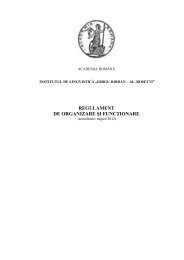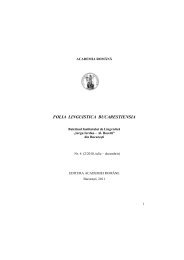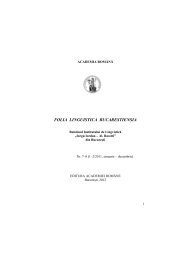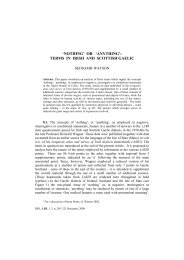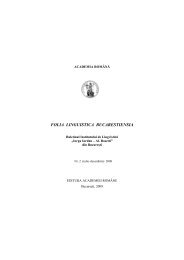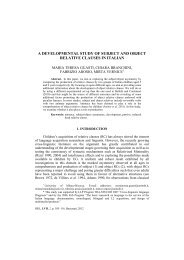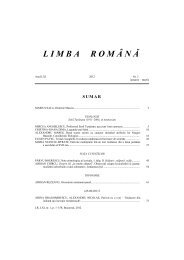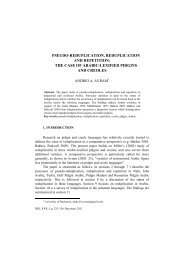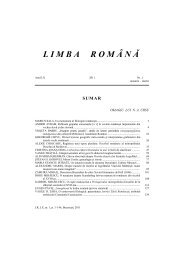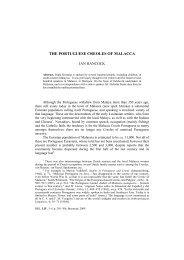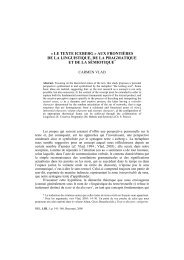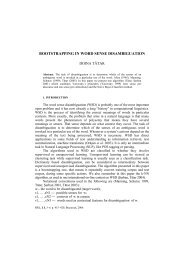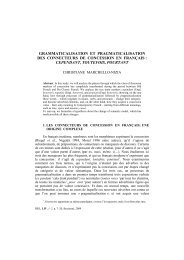GABRIELA PANÄ DINDELEGAN (coord.), Limba românÄ â Aspecte ...
GABRIELA PANÄ DINDELEGAN (coord.), Limba românÄ â Aspecte ...
GABRIELA PANÄ DINDELEGAN (coord.), Limba românÄ â Aspecte ...
- No tags were found...
Create successful ePaper yourself
Turn your PDF publications into a flip-book with our unique Google optimized e-Paper software.
522Comptes rendus 16The last paragraph of Part I is set aside for a morphological typology of languages, a commondescription of locating languages on a scale of synthesis, bordered at one end by the isolatinglanguages, and at the other, by polysynthetic languages.The first part of chapter Derivation (Part II. Word Formation) contains a debate over theapplicability of William’s Right-hand Rule (1981) – in morphology, we define the head of amorphologically complex word to be the right-hand member of that word (p. 54) –, and over thehistorical background and explanation of this rule. Conversion is subsumed in this chapter toderivation (lexeme formation), arguing that in the same language we may obtain a verb either from anadjective without an affix (wet → to wet), or from an adjective with an affix (damp → to dampen),but also with other arguments (trans-language phenomena – in English and Dutch the middle verbformation doesn’t need an affix, whereas in Russian it does – and their syntactic consequence is themodification of their syntactic valency). The necessity of listing words in the lexicon is given in theparagraph Templates and idiosyncrasies two (possible) motivations: the fact that it is a conventionalway of pointing out the existence of a unit and of a meaning and the fact that the lexicon listsparticular properties of the word, properties that cannot be predicted from the rule (the Germandeverbal adjective essbar formed from the verb essen “to eat” does not only mean “that can be eaten”,as the suffix generally supposes, it means “that can be safely eaten”; the constraint safely is anindividual property which cannot be predicted from the template [= morphological rule]). Thischapter also approaches different constraints that can affect derivation: morphologic, syntactic,semantic (type coercion: the affix imposes a particular interpretation on the derived word as awhole), phonological, suprasegmental/prosodic constrains, stratal constrains (stratum “a layer of thelexicon of a particular historical origin”; the existence of stratal constrains implies a neo-classicalword-formation process), and base-driven restrictions, all illustrated with examples from English,Dutch, German and other languages. In the paragraph concerning Productivity, the author extends thisconcept to the domains of compounding and inflection; in the case of word-formation throughderivation, the productivity matter is discussed referring to two tests: type frequency and tokenfrequency; the topic is also discussed from a historical point of view.The chapter on Compounding (Part II. Word Formation) begins with the evaluation of thetypes of compounds, applying the principles also used in the chapter on Derivation; he speaks ofendocentric and exocentric compounds, bahuvrihi, copulative and appositive compounds, withexamples from Sanskrit, Dutch, German and English. A part of the chapter on Compounding isdedicated to the discussion compound vs. phrase vs. derived words; phrases and compounds are veryalike, especially because phrases can have the same function as words (of labelling name-worthycategories) and because phrases and compounds often have the same structure, as a consequence ofthe fact that compound patterns evolved historically from phrasal word combinations. The authorgives some criteria of differentiation for situations from some Indo-European languages: forGermanic languages, like Dutch and German, an inflectional criterion is raised; for English, the onlycriterion of differentiation is a phonetic one, the stress etc. Regarding compounds vs. derived words,the author speaks about the process of grammaticalization, with examples from Dutch and English.The last part of this chapter contains information about specific compounding processes (syntheticcompounding, noun incorporation) and recurrent phenomena in compounding (stem allomorphy).The chapter on Inflection (first chapter from Part III. Inflection) begins with a presentation ofthe inflectional properties (finite vs. non-finite forms, grammatical categories expressed throughinflection etc.), and continues with the presentation of the roles of inflection, speaking aboutcontextual vs. inherent inflection, structural and semantic cases, agreement, government, all thesefrom a morphological perspective and with examples from many languages, examples which makethe exposition clearer. A unit is dedicated to the distinction between inflection and derivation, whichis based on some criteria: inflection is obligatory; the paradigm has a more important role in inflectionthan in derivation; the demarcation criterion (the morphological properties that play a role inagreement and government are clear cases of inflection, p. 112); inflection is in most casessubsequent to derivation, etc. The inflectional phenomena are discussed from the point of view ofseveral theoretic models: Item-and-Arrangement Morphology, Item-and-Process Morphology,



